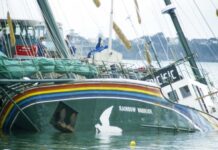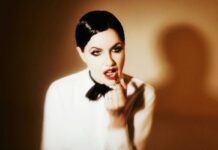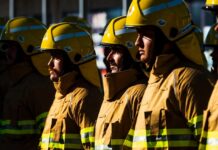Our weekly arts diary
At the Community Art Gallery until 18 September, Showcase presents the works of previous artists in residence including Sarah Guppy, Phil Newbury, Stephen Mulqueen, Susanne Kerr and one of its most prolific, Michel Tuffery.
A resident for three months in 2016, Michel says, “It felt like six months. It was awesome.” His exhibition Reading Middens, Tracing Lines draws on the history of the Pacific and the connections between Tahiti, the Cook Islands and New Zealand pre-colonial settlement.
A collection of woodcut prints, bronze sculptures and laser-cut wall art features traditional motifs and contemporary references derived from his explorations of middens and the island’s 50-plus pa sites. Michel also attempted to track canoes that arrived on Waiheke when the tuakana, or old ones, replenished their supplies on their way to Rarotonga.
The bronze sculpture Polynesian Panther Gold alludes to the blackbirding days when, in 1862 and 1863, Peruvian slave traders took a shocking number of Cook Islanders hostage.
An estimated three-quarters of the population of Penrhyn Atoll, their first port of call, was taken to Peru and sold into slavery. “I transferred some traditional designs onto the panther to acknowledge those who never made it back home.”
Two cast aluminium black eagle stingrays serve as the symbolic protectors of Nga Kina, Michel’s large waterfront sculpture in Wellington. “Every summer, various species of stingray turn up there,” he explains. “They come into the harbour, right into the city, and sunbathe along the shore. You can see them cruising up and down. It’s pretty cool to watch.”
Despite this, no one took much notice of the migrating stingrays until he installed his kina, half submerged in the sea but revealing themselves when the tide goes out.
Tava’e ma le lua Solofonua at Brandenburg Gate, an intricate rimu comb, references German architectural fretwork from the First World War era as well as his own heritage (Michel’s mother is Samoan). “It’s my artistic response to the German history and architecture in Samoa at that time.”
Also at the gallery, Outsider Art, curated by Barbara Robinson, includes the work of two artists from Awhina Mai Tatou Katoa, a social group that connects the homeless community through culture. In partnership with the Auckland City Mission, Awhina Mai Tatou Katoa runs toi and whakairo open days aimed at creating learning and networking opportunities for marginalised Aucklanders.
In June, artists from the group organised a day on Waiheke with master carver Chris Bailey, culminating in the opening of the Community Art Gallery’s Matariki exhibition.
Through curator Jeanine Clarkin, some of the artists, including Frederick Henare and Richard Turipa, were able to show their work there. In doing so, they learned about the upcoming Outsider Art exhibition.
“We’re happy to keep the exhibition ball rolling,” says Awhina Mai Tatou Katoa coordinator Anna Gates. “It has been a learning curve for us but enormously inspiring to the artists to get work out there and have it selling.”
Tiare Turetahi, who has two works in the exhibition, Taonga Tuku Iho and Mate Whenua, incorporates Maori patterns into a cosmos theme. A carving tutor for the homeless in Auckland City, Tiare has been painting for the last six months while waiting for summer – “a better time for carving” – to arrive.
“This is the first set of paintings I’ve ever done,” he says. “I’m in a different realm, a different stratosphere. I’ll look at blank canvas and all the Maori patterns come up, so I just grab a paintbrush and make it happen.”
Collaborating with established artist Selwyn Vercoe, Tiare has been influenced by his style. “There are a lot of straight lines in my work. I’m basically watching other artists and taking a bit out of their style and making it my own.”
Of his usual art form, he says: “My carving is a vehicle to break down barriers and stereotypes about the homeless. It’s about creating a space for the homeless and, if they don’t want to be involved, I can at least feed them.”
Returning to the gallery is Richard Turipa, with his acrylic on canvas, O’I Aotearoa. “It basically just reminds me of sitting in the bush, sitting around the beach and the rivers like in the old days growing up. I never really did art growing up; I never thought I could do art.”
Although he finds people’s interpretations of his works illuminating, he says, “It’s hard for me to talk about my art because I don’t feel like an artist. I started it for therapy, and now I look around my apartment and I see all my artwork, so I think, whoa, you must be something. But I still don’t want to call myself an artist.”
Richard himself has been homeless several times, most recently for a period of eight weeks. In conjunction with the library and Auckland Council, he helped set up open art days “for likeminded people who wanted to get together and do some art, carving and just do something positive. It gives me a purpose and it helps me learn about how I can help the people in my country.”
• Anna Ngo







